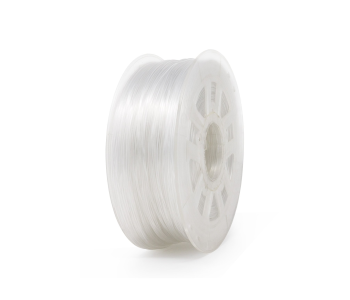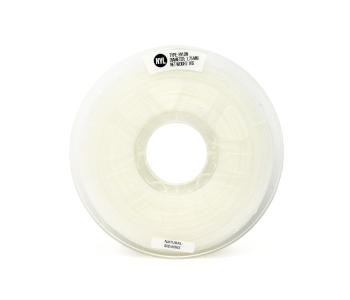Top 5 Best Clear 3D Printing Filaments
Making clear or transparent projects is one of the most interesting things you can do with 3D printing. If you know what you’re doing, you can make custom frames for photos or a glass-like vase for flowers. Just a disclaimer here – 3D-printed plastics are closer to being translucent than truly transparent. It is simply a limitation of the technology.
There are several different filaments that can be used to make clear builds. They are not all equally made. One filament may have better optical properties, but the others may be more durable or easier to work with. Let’s look at our top five options for clear filaments.
1. PETG

PETG has a couple of advantages that make it our top choice for clear filaments. The first is that it’s one of the few 3D printing plastics that is naturally clear. This helps in achieving the best optical properties, despite the limitations of 3D printing.
It also helps that PETG is considered the filament that combines many of the best things about other popular 3D printing filaments. It has good thermal resistance, mechanical strength, chemical stability, and is not prone to warping during printing. PETG is considered by many to be one of the easiest filaments to work with and is quickly becoming very popular in 3D printing communities.
Of the available options out there for clear PETG filament, the OVERTURE Transparent PETG filament is one of the most popular. The clarity of prints from this filament are impressive, even before post-processing. It’s also not very expensive at only a little above $20 for a 1-kilogram spool.
2. PMMA

Polymethylmethacrylate (PMMA) is not a very common material used in 3D printing. There are good reasons for this, but it’s also one of the best candidates for making clear or translucent projects. After all, PMMA is the same material used in acrylic sheets.
Aside from its good optical properties, PMMA is UV-resistant and is very strong and long-lasting. Like ABS, PMMA can be dissolved by acetone. This means that PMMA prints can be smoothed by acetone vapor, one of the easiest and most reliable post-processing methods. This is a huge advantage as smoothing can massively improve the optical properties of a finished print.
The downsides of PMMA are quite notable, contributing to why it’s not very popular for 3D printing. Like many other high-temperature filaments, PMMA is prone to warping. It is also a toxic material. If you want to create something meant for food contact, using PMMA should be out of the question.
Since it’s not very popular, there are not many options when it comes to clear PMMA filament. The only brands available on Amazon are MSNJ and QDTD. These aren’t exactly household names in 3D printing, so you’ll have to take a bit of a gamble.
3. PLA

PLA is not a naturally clear material, but some chemical treatment has yielded a host of clear PLA filaments. This material needs no introduction. It is one of the most popular 3D printing filaments because of how easy it is to use. PLA does not warp, does not emit an unpleasant smell during printing, and is sourced from sustainable plant material.
Since PLA is not naturally clear, it is not the best option in terms of optical properties. Clear PLA prints often come out with a faint yellow or white tinge. Quality can vary from one filament brand to another.
If you’re buying clear PLA filament, we suggest sticking with the tried-and-true brands. The best option is either SUNLU or Gizmo Dorks. Both filaments are inexpensive, although the filaments from these brands have been known to be hit-or-miss in terms of printing performance.
4. Nylon

Nylon is another thermoplastic that benefits from being naturally clear. You have probably already seen how close to being transparent Nylon plastic bags or films are. 3D printing with Nylon comes close to this optical quality.
Nylon is known as a particularly durable but lightweight material. It is exceptionally strong and is resistant to chemical degradation and physical abrasion. If you’re worried about your product getting scratched easily, then Nylon may be your best option for filament.
The biggest downside of Nylon is that it’s highly prone to warping. Getting good prints with Nylon means using every trick in the bag to improve bed adhesion – a heated bed, adhesives, a cooling fan, perhaps even printing with a raft or brim. Nylon is also exceptionally hygroscopic, so you will have to figure out how to keep it dry while printing.
There are several good Nylon filaments available. We recommend the Natural Clear Nylon Filament from Gizmo Dorks.
5. TPU

The operative word when describing TPU is ‘flexible.’ TPU is the go-to filament if you want to 3D print products that are rubber-like and have very high impact resistance. It is usually used in making protective sleeves or cases for sensitive electronics. TPU can be prepared to be naturally clear upon manufacturing.
TPU can be uniquely challenging if you have never worked with it before. The most common issue encountered with TPU is stringing, owing to its very low viscosity. It is often advised to print slowly, at low temperatures, and with retraction enabled. It might take a bit of trial and error, but it’s certainly doable.
There is a wide selection of clear TPU filaments available. Among the most trusted are the NinjaTek Cheetah TPU Filament, TRONYX Clear Flexible TPU, and PolyMaker High Flow TPU Filament.
Tips on making clear 3D prints
Even when printing with clear filament, the optical quality of the finished product is not guaranteed. If you want to make your prints as close to transparent as possible, you will have to tweak your printer settings based on some basic optics concepts.
Print with thick layers
To make an object transparent, we will have to reduce any internal diffraction or reflection. This can be hard to do in 3D printing, as the boundaries between layers will almost certainly disrupt the path of light rays, especially if the layers are not completely fused.
To avoid this problem, it is advised to print with as high a layer thickness as possible. This reduces the number of layer boundaries and makes the layers more spherical. With this setup, internal reflections are minimized. You can even consider using a nozzle with a wider diameter just to take advantage of this phenomenon.
Print at high temperatures
Another goal you should aspire for when 3D printing clear objects is to make the layers fuse with each other as well as possible. This minimizes internal reflection and light diffractions through the layer boundaries.
The conventional wisdom would be to print at the highest allowed temperature for the filament that you are using. You can experiment a bit and go beyond the recommended temperature by a few degrees in the hopes of improving the optical properties of the finished product. Just keep an eye out for stringing or over-extrusion problems. This is not a strategy that we would recommend for printing with TPU.
Print at 100% infill
If you’re making solid pieces, then the only way to really achieve good transparency is to print at 100% infill. Light reflects and refracts when it passes through different materials. If the infill of your product is only partially filled, it would be almost impossible for light to pass through at all. You will just end up with something that seems clear on the outside but has a solid white core.
Smooth and polish
Taking the time to smooth and polish your finished print goes a long way towards achieving a close-to-transparent look. This gets rid of any surface imperfections and may even dull away the layer boundaries. Again, this reduces any untoward reflection or refraction and makes it easier for light to pass through.
The usual way to finish a 3D print is by sanding. Although old-fashioned, this is still the best and most precise way of post-processing. You will want to do this using sandpaper with different grit grades, finishing off with one that is incredibly fine. A 4000-grit sandpaper should do very nicely
Sanding is the recommended way of post-processing if you’re printing with PLA, PETG, Nylon, or TPU. If you’re using PMMA, then you have the luxury of exploring vapor smoothing with acetone. This method is a lot faster and gives fairly consistent results at a fraction of the effort involved.
Making transparent 3D prints can seem frustrating at first. There is basically no room for error, as a small misprint can quickly ruin the aesthetics of a project that is meant to be clear. A bit of understanding of how light behaves can go a long way towards helping you refine your technique.
Final thoughts
There are lots of guides out there that repeat many of the same recommendations for 3D printing clear objects or surfaces. We have mentioned those as well – print with thick layers, high temperatures, and take it slow. Post-processing also plays a huge role.
Perhaps even more important is making sure that you’re printing with a high-quality clear filament. As we mentioned, not all clear filaments are made equal. You will probably get better results with PETG or Nylon compared to PLA.


